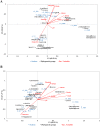Spatial Variability of Picoeukaryotic Communities in the Mariana Trench
- PMID: 30337591
- PMCID: PMC6194128
- DOI: 10.1038/s41598-018-33790-4
Spatial Variability of Picoeukaryotic Communities in the Mariana Trench
Abstract
Picoeukaryotes play prominent roles in the biogeochemical cycles in marine ecosystems. However, their molecular diversity studies have been confined in marine surface waters or shallow coastal sediments. Here, we investigated the diversity and metabolic activity of picoeukaryotic communities at depths ranging from the surface to the abyssopelagic zone in the western Pacific Ocean above the north and south slopes of the Mariana Trench. This was achieved by amplifying and sequencing the V4 region of both 18S ribosomal DNA and cDNA using Illumina HiSeq sequencing. Our study revealed: (1) Four super-groups (i.e., Alveolata, Opisthokonta, Rhizaria and Stramenopiles) dominated the picoeukaryote assemblages through the water column, although they accounted for different proportions at DNA and cDNA levels. Our data expand the deep-sea assemblages from current bathypelagic to abyssopelagic zones. (2) Using the cDNA-DNA ratio as a proxy of relative metabolic activity, the highest activity for most subgroups was usually found in the mesopelagic zone; and (3) Population shift along the vertical scale was more prominent than that on the horizontal differences, which might be explained by the sharp physicochemical gradients along the water depths. Overall, our study provides a better understanding of the diversity and metabolic activity of picoeukaryotes in water columns of the deep ocean in response to varying environmental conditions.
Conflict of interest statement
The authors declare no competing interests.
Figures






Similar articles
-
Comparison of Deep-Sea Picoeukaryotic Composition Estimated from the V4 and V9 Regions of 18S rRNA Gene with a Focus on the Hadal Zone of the Mariana Trench.Microb Ecol. 2022 Jan;83(1):34-47. doi: 10.1007/s00248-021-01747-2. Epub 2021 Apr 3. Microb Ecol. 2022. PMID: 33811505
-
Size-fractionated diversity of eukaryotic microbial communities in the Eastern Tropical North Pacific oxygen minimum zone.FEMS Microbiol Ecol. 2015 May;91(5):fiv037. doi: 10.1093/femsec/fiv037. Epub 2015 Apr 1. FEMS Microbiol Ecol. 2015. PMID: 25873468
-
Picoeukaryotic diversity and distribution in the subtropical-tropical South China Sea.FEMS Microbiol Ecol. 2014 Sep;89(3):563-79. doi: 10.1111/1574-6941.12357. Epub 2014 Jun 23. FEMS Microbiol Ecol. 2014. PMID: 24849025
-
Effects of shallow-water hydrothermal venting on biological communities of coastal marine ecosystems of the western Pacific.Adv Mar Biol. 2006;50:267-421. doi: 10.1016/S0065-2881(05)50004-X. Adv Mar Biol. 2006. PMID: 16782453 Review.
-
Unveiling new microbial eukaryotes in the surface ocean.Curr Opin Microbiol. 2008 Jun;11(3):213-8. doi: 10.1016/j.mib.2008.04.004. Epub 2008 Jun 13. Curr Opin Microbiol. 2008. PMID: 18556239 Review.
Cited by
-
Biogeography and Population Divergence of Microeukaryotes Associated with Fluids and Chimneys in the Hydrothermal Vents of the Southwest Indian Ocean.Microbiol Spectr. 2022 Oct 26;10(5):e0263221. doi: 10.1128/spectrum.02632-21. Epub 2022 Sep 19. Microbiol Spectr. 2022. PMID: 36121256 Free PMC article.
-
Fungal community analysis in seawater of the Mariana Trench as estimated by Illumina HiSeq.RSC Adv. 2019 Feb 28;9(12):6956-6964. doi: 10.1039/c8ra10142f. eCollection 2019 Feb 22. RSC Adv. 2019. PMID: 35518513 Free PMC article. Review.
-
Geographical distribution and driving force of microbial communities in the sediments of Diamantina and Kermadec trenches.Front Microbiol. 2024 Nov 18;15:1474645. doi: 10.3389/fmicb.2024.1474645. eCollection 2024. Front Microbiol. 2024. PMID: 39624723 Free PMC article.
-
Marked changes in diversity and relative activity of picoeukaryotes with depth in the world ocean.ISME J. 2020 Feb;14(2):437-449. doi: 10.1038/s41396-019-0506-9. Epub 2019 Oct 23. ISME J. 2020. PMID: 31645670 Free PMC article.
-
Comparison of Deep-Sea Picoeukaryotic Composition Estimated from the V4 and V9 Regions of 18S rRNA Gene with a Focus on the Hadal Zone of the Mariana Trench.Microb Ecol. 2022 Jan;83(1):34-47. doi: 10.1007/s00248-021-01747-2. Epub 2021 Apr 3. Microb Ecol. 2022. PMID: 33811505
References
Publication types
MeSH terms
Substances
Grants and funding
- XDB06010202/Chinese Academy of Sciences (CAS)/International
- 41776147/National Natural Science Foundation of China (National Science Foundation of China)/International
- 16128416/Research Grants Council, University Grants Committee (RGC, UGC)/International
- 16101917/Research Grants Council, University Grants Committee (RGC, UGC)/International
LinkOut - more resources
Full Text Sources

